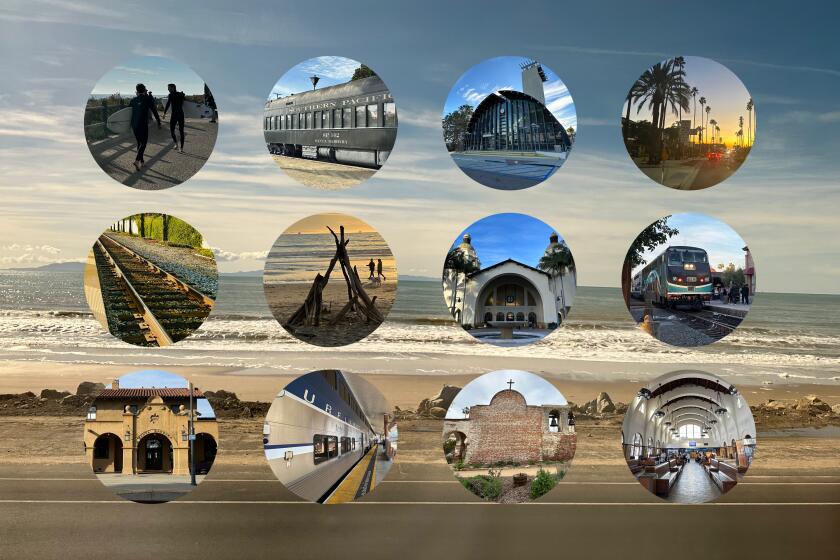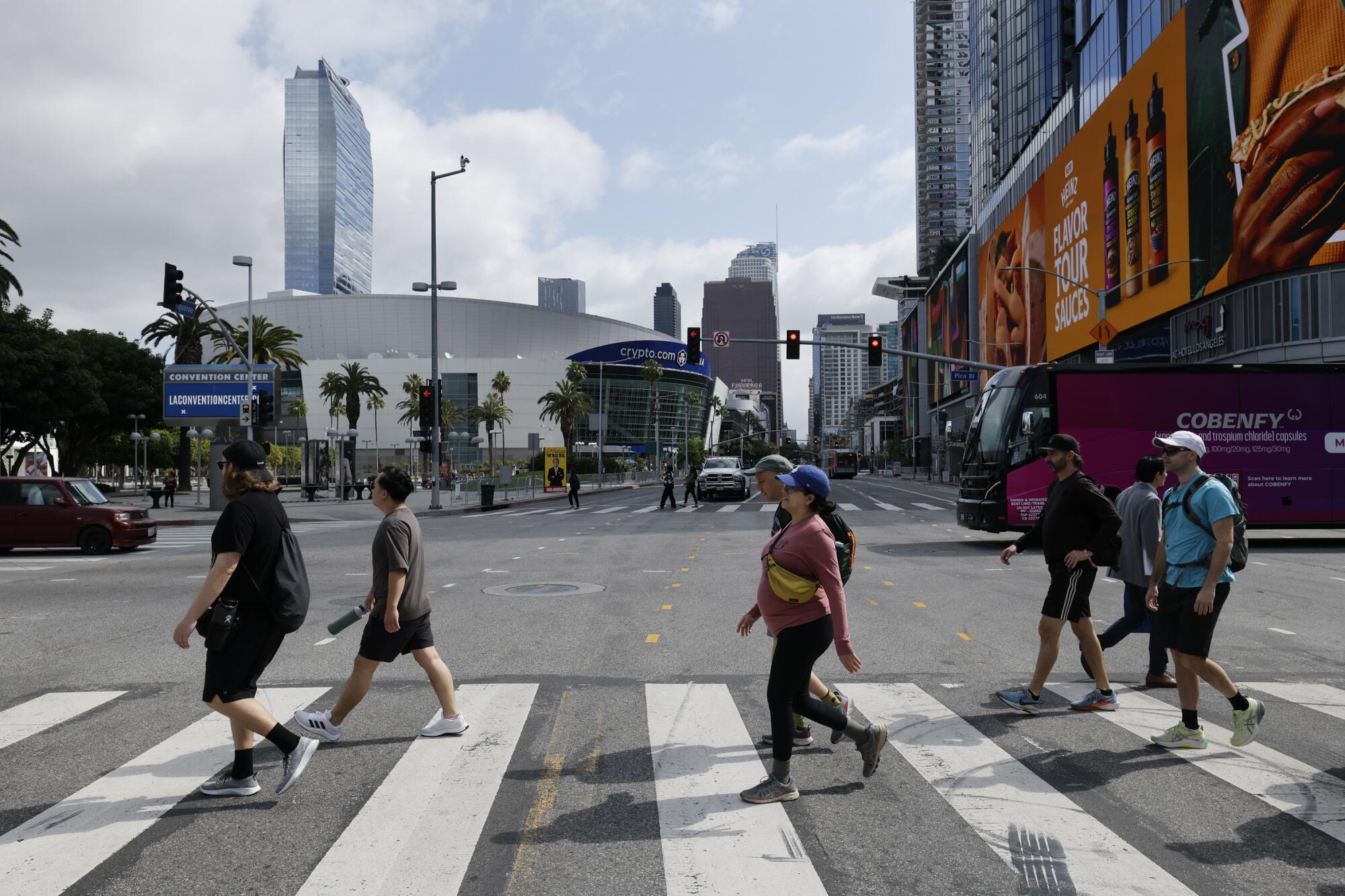
- Share via
We took about 37,000 steps forward and one step back.
For the fourth iteration of what friends and I playfully call our annual big walk, we embarked on a considerably easier quest. One year after delineating our limits by walking all 28-plus miles of Western Avenue, two years after surmounting all 25-plus miles of Sunset Boulevard, we settled on perambulating Pico Boulevard this month.

It lacked the grandiosity of our past pursuits. But Pico’s 15.5 miles presented plenty of opportunities — to chat, to consider, to explore, to linger. We met at 9 a.m. on the outskirts of downtown and finished about 9½ hours later on the Santa Monica sand. Along the way we ran into friends, made new ones and reconnected with welcome parts of our collective home.
Our guiding principles are simple. After selecting one long Los Angeles street that ends at the ocean, we start walking at its other terminus. Ideally, there’s some sort of special marker there. While Western has the Fern Dell Stairs, Sunset’s start is unceremonious. Wilshire Boulevard, the site of our first walk in 2022, has eight out-of-place palm trees, perhaps planted as a hint of what’s to come. Pico wins with a giant Coca-Cola bottle, outside an entrance to the company’s storied bottling facility designed in Streamline Moderne architectural fashion.
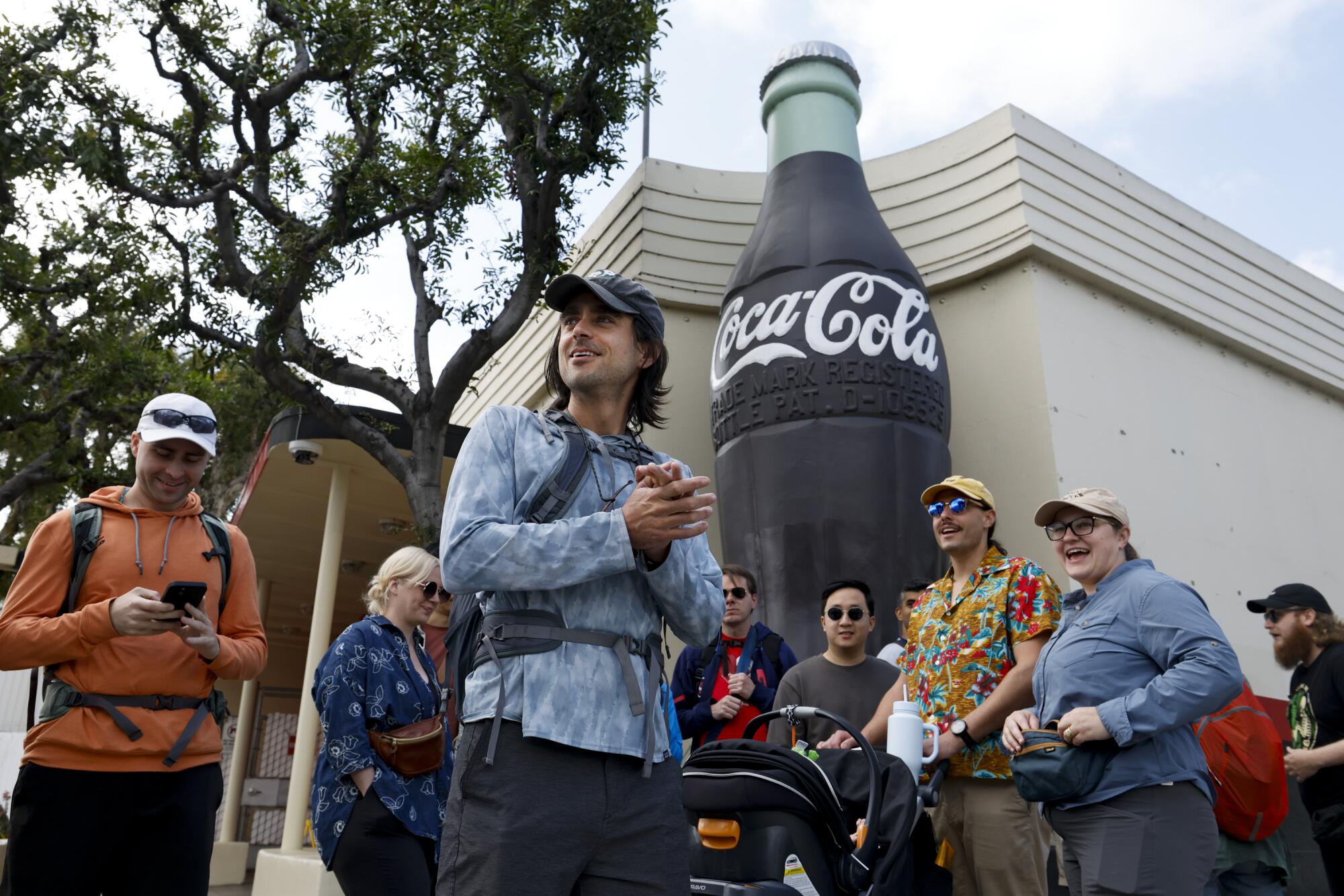
It was when they mastered the freeways, needed a hoodie any time the weather dipped below 70 and would randomly sing, ‘Keyes, Keyes, Keyes on Van Nuys!’
We started there and never turned. Two miles in, at Pico’s intersection with Union Avenue, we took over the street itself as part of CicLAmini. The car-free event put on by a local nonprofit was just beginning, so the street almost felt like ours alone. And we’ve walked enough to know how rare a public restroom is in Los Angeles, so the portable toilets were appreciated.

Eight miles in, we stopped for lunch in Pico-Robertson, where options abounded. Pico, of course, was the street on which the late, great Jonathan Gold once set out to eat at every restaurant, and Pico-Robertson was the neighborhood where he resided during that pursuit.
We didn’t have that much time. We did, however, split up and sample an array of restaurants: a lauded Tokyo- and Neapolitan-style pizza place called Pizzeria Sei, neighborhood classics Factor’s Famous Deli and Jeff’s Gourmet Sausage Factory, and the Rooster, a newer addition. We would’ve loved to eat all together, but there is a remarkable dearth of green spaces near Pico, throughout the city of Los Angeles. Public green spaces, we should say, for we soon encountered back-to-back golf courses covering more than a mile.
Pico proved pedestrian-friendly, at least compared to our past pursuits. Sidewalks exist for almost every step of the way. And, for several stretches, they have history built into them. Surrounding Bonnie Brae Street, in Pico-Union, there are a number of Victorian houses, modeled after actual nearby houses, engraved into the sidewalk. In eastern Santa Monica, information about the street and surrounding area is at several locations painted into the sidewalk, forming a timeline as you approach the Pacific.

Just don’t try to veer to the north or south. Between Arlington Avenue and La Brea Avenue, there are several gates visible from Pico that block both vehicles and pedestrians from easily visiting nearby neighborhoods. The gates, funded by neighborhood councils, date to the 1980s. They have remained a hotly contested issue in recent city council races.
And don’t accept every apparent office building at face value. At neither the Packard Well Site nor the Cardiff Tower, about 1½ miles apart, did we stop and take notice of the strange, tall facades shielding us from something. If we had, we would’ve realized there were no windows. There are not offices but massive oil derricks and rigs inside. As part of a 2015 survey on historic districts, the Los Angeles Department of City Planning called the Cardiff Tower “significant as a rare remaining oil production facility located on a commercial corridor.” Los Angeles!
Pico only calls two cities home, L.A. and Santa Monica, which is rare among our long streets that tend to snake between many cities. But double-digit Los Angeles neighborhoods include the street in some capacity. It feels like a relentless parade of new neighborhoods. At the northeast corner of the intersection with Fairfax Avenue, there are even signs for two neighborhoods that somehow start in exactly the same place: Wilshire Vista and Little Ethiopia.
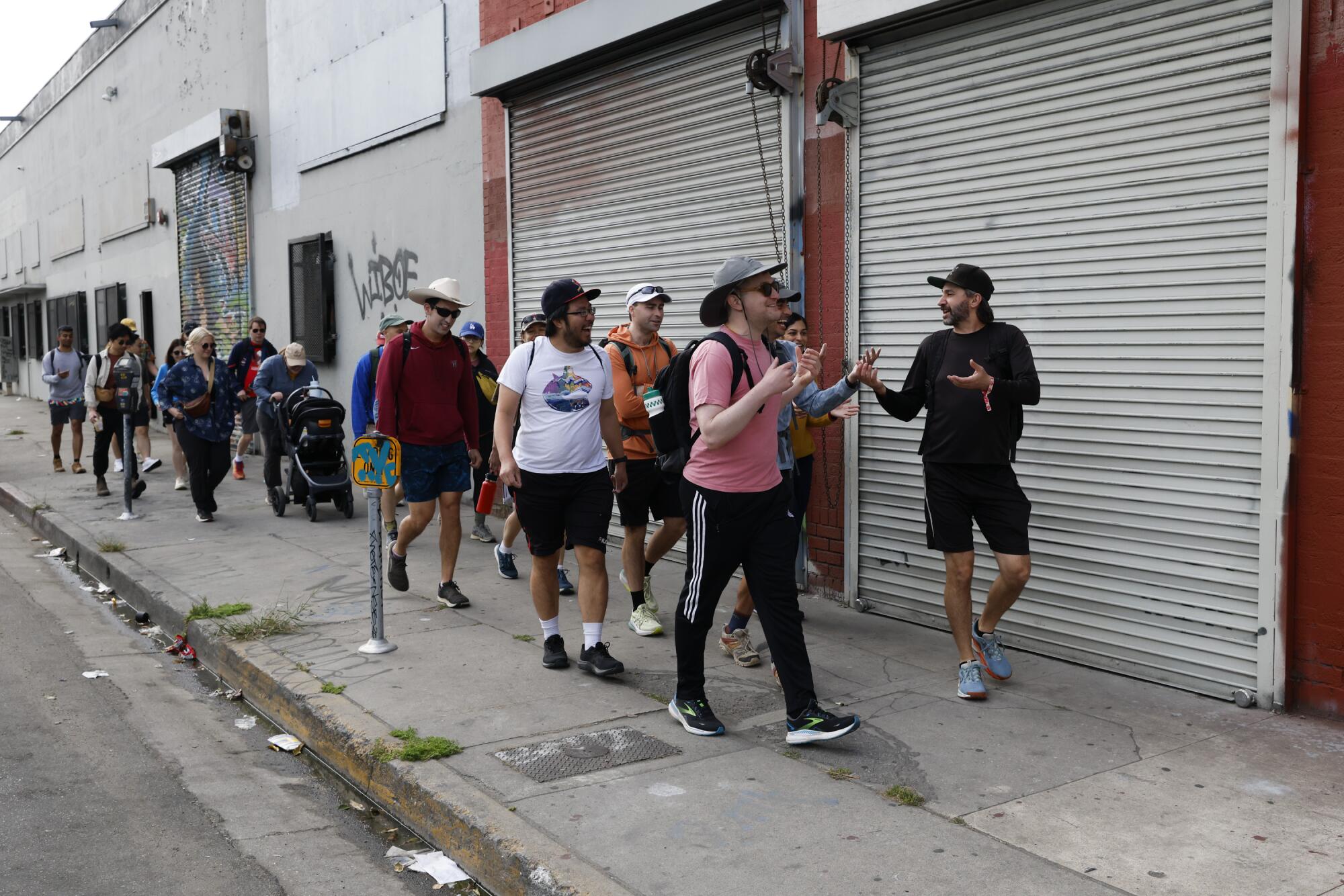
From the Venice Boardwalk to Rodeo Drive and Boyle Heights’ Cesar E. Chavez Boulevard, these walks allow you to experience L.A.’s streets and sidewalks by foot.
At the Daily Pint, where we sourced sustenance for our final leg, the bartender could tell something was up as soon as we all walked in, sweaty and setting down our backpacks. Just the week before, she told us, a similarly disheveled man came in on a solo journey from downtown to Pacific Palisades. It was his punishment for coming in last place in his fantasy football league. We told her we were just doing this for fun. She didn’t say anything for a few seconds, then asked what we wanted to drink.
Soon enough we were on the beach, admiring the last of the day’s sun with the Santa Monica Pier as our backdrop. Pico actually meets the sand in a way that we have not seen with any other long streets. At its last intersection, with Appian Way, there’s a little valet circle for a hotel restaurant, and anything resembling a typical road ends. Then there are eight steps down and 100 feet of connected S-shaped sidewalks guiding pedestrians down to the beach. That’s still Pico Boulevard, according to every map we consulted. It’s like an artist’s last, tasteful touch.
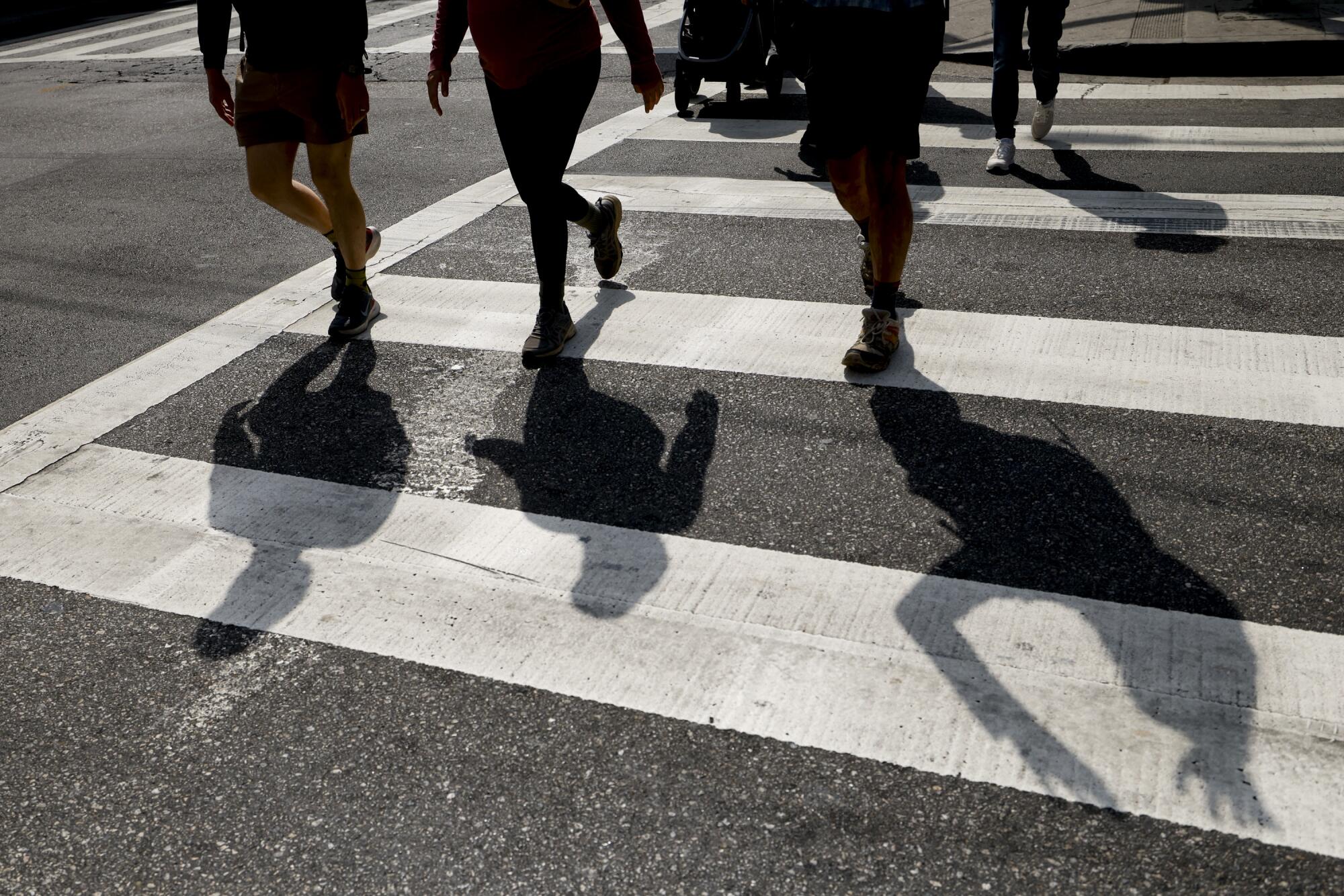
This was our largest group yet: 22 starters and 19 finishers, including one fearless 4-month-old. January’s Eaton fire displaced four of our walkers, two of whom remain marooned far from home for at least a little while longer. Everything still feels a bit different here, obviously. The downsides of Los Angeles life might be a little more top of mind.
All that, combined with blessedly less mileage to cover, gave this walk a different feeling than in years past. Less delirious, more contemplative, with more time to notice, to share memories with peers.
Most of us have been here long enough to remember old iterations of spaces. One nail salon used to be a coffee shop, where a few of us first learned about Ethiopian coffee ceremonies. Catch One, now a club where bottle service with Jack Daniel’s sells for $400, used to be Jewel’s Catch One, one of America’s oldest Black-owned discos and gay bars. The iconic Papa Cristo’s Greek Grill, at Pico and Normandie, just closed, its building now for sale for more than $5 million.

Some spaces continue to reign. The Mint, the music venue that once hosted the likes of Ray Charles and Stevie Wonder, has been around for 88 years. The Apple Pan is not far behind, at 78 years, long outlasting the Westside Pavilion across the street.
We’ll take the ease of ticket purchasing, relaxed atmosphere in the stations and breathtaking scenery of train travel over the angst of driving any day.
One thoughtful walker brought along a book of Mary Oliver poems and slowly flipped through it during lulls. She asked others to stop her whenever they felt like it and read the resulting poem aloud.
Toward the day’s end, we happened on “Yes! No!,” which was first published in 1994.
“How important it is to walk along, not in haste but slowly, looking at everything and calling out Yes! No!” reads one portion. “Imagination is better than a sharp instrument. To pay attention, this is our endless and proper work.”
We were not perfect. But on this day, it is fair to say, we completed our work. And what a luxury it was to do it once more.
More to Read
Sign up for The Wild
We’ll help you find the best places to hike, bike and run, as well as the perfect silent spots for meditation and yoga.
You may occasionally receive promotional content from the Los Angeles Times.


